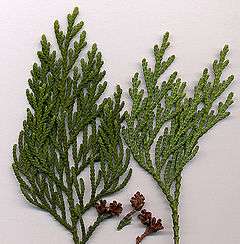Thuja standishii
| Thuja standishii | |
|---|---|
 | |
| Thuja standishii foliage and cones upper side left, under side right | |
| Scientific classification | |
| Kingdom: | Plantae |
| Division: | Pinophyta |
| Class: | Pinopsida |
| Order: | Pinales |
| Family: | Cupressaceae |
| Genus: | Thuja |
| Species: | T. standishii |
| Binomial name | |
| Thuja standishii (Gordon) Carr. | |
Thuja standishii (Japanese Thuja; nezuko, kurobe) is a species of thuja, an evergreen coniferous tree in the cypress family Cupressaceae. It is native to southern Japan, where it occurs on the islands of Honshū and Shikoku. It is a medium-sized tree, reaching 20–35 m tall and with a trunk up to 1 m diameter.
The foliage forms in flat sprays with scale-like leaves 2–4 mm long, matte green above, and with narrow white stomatal bands below. The cones are oval, yellow-green ripening red-brown, 6–12 mm long and 4–5 mm broad (opening to 8 mm broad), with 6–10 overlapping scales.
It is an important timber tree in Japan, grown in forestry plantations for its durable, waterproof, attractively scented wood.
References
- Conifer Specialist Group (1998). "Thuja standishii". IUCN Red List of Threatened Species. Version 2006. International Union for Conservation of Nature. Retrieved 12 May 2006.
External links
This article is issued from Wikipedia - version of the 11/7/2016. The text is available under the Creative Commons Attribution/Share Alike but additional terms may apply for the media files.
